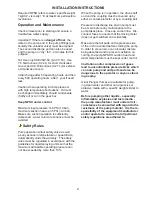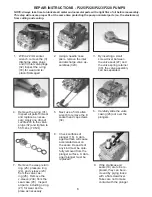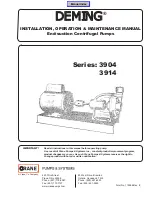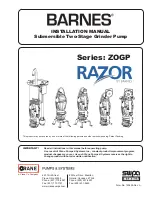
2
INSTALLATION INSTRUCTIONS
When the pump is in operation, the drive shaft
end and the coupling must be covered up by
either a contact-protector or by a coupling bell.
Pressure in discharge line and in pump must
be at zero before any maintenance to the
pump takes place. Close up suction line. Dis-
connect fuses to ensure that the driving motor
does not get switched on accidentally.
Make sure that all parts on the pressure side
of the unit are vented before starting the pump.
In order to preven air, or an air-water mixture
being absorbed and to prevent cavitation oc-
curring, the pump NPSHR suction head and
water temperature must be kept under control.
Cavitation and/or compression of gases
lead to uncontrollable pressure kicks which
can ruin pump and unit parts and also be
dangerous to the operator or anyone stand-
ing nearby.
Giant Plunger Pumps are suitable for pump-
ing clean water and other non-agressive or
abrasive media with a specific weight similar to
water.
Before pumping other liquids - especially
inflammable, explosive and toxic media -
the pump manufacturer must under all cir-
cumstances be consulted with regard to the
resistance of the pump material. It is the re-
sponsibility of the equipment manufacturer
and/or operator to ensure that all pertinent
safety regulations are adhered to.
Required NPSH refers to water: specific weight
1kg/dm
3
, viscosity 1°E at maximum permissible
revolutions.
Operation and Maintenance
Check oil level prior to starting and ensure a
trouble-free water supply.
Important! If there is a
danger of frost
, the
water in the pump and in the pump fittings (par
-
ticularly the unloader valve) must be emptied.
The second discharge port can also be used
and the pump run “dry” for 1-2 minutes for this
purpose.
Oil: Use only SAE 20W-50 (p/n 01153). Use
7.5 fluid ounces (0.22 L) for short crankcase
covers and 9.0 fluid ounces (0.27 L) for extend
-
ed crankcase covers.
Initial change after 50 operating hours and then
every 500 operating hours, after 1 year if used
less.
Caution when operating in damp places or
with high temperature fluctuations. Oil must
be changed immediately, should condensate
(frothy oil) occur in the gear box.
Keep NPSH under control.
Maximum input pressure 145 PSI (10 bar),
maximum suction head -4.35 PSI (-0.3 bar).
Make sure suction pulsation is sufficiently
dampened - water column resonance must be
avoided.
Safety Rules
Pump operation witout safety valve as well
as any excess in temperature or speed limits,
automatically voids the warranty. The safety
valve must be regulated in accordance with the
guidelines for liquid spraying units so that the
maximum admissible operating pressure can
not be exceeded by more than 10%.


























